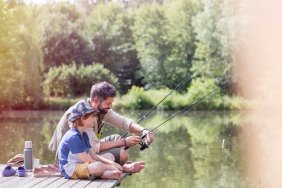 When it comes to fly fishing, the physical act of fishing is only a part of the sport. True fly anglers can attest to how integral fly tying is to fly fishing. There’s just something about taking the time to diligently craft a nymph or streamer—a custom-made one-of-a-kind fly—and using it to hook a beauty the next time you hit the river. Fly tying isn’t something you just tackle head-on, though. The delicate craft takes some time to ease into, and fly tying beginners will want to get some mileage on some of the easier models to tie. I’ve listed a few such models for you today, to help those of you who are thinking of venturing into fly tying take those first few steps.
When it comes to fly fishing, the physical act of fishing is only a part of the sport. True fly anglers can attest to how integral fly tying is to fly fishing. There’s just something about taking the time to diligently craft a nymph or streamer—a custom-made one-of-a-kind fly—and using it to hook a beauty the next time you hit the river. Fly tying isn’t something you just tackle head-on, though. The delicate craft takes some time to ease into, and fly tying beginners will want to get some mileage on some of the easier models to tie. I’ve listed a few such models for you today, to help those of you who are thinking of venturing into fly tying take those first few steps.
One of the easiest flies for beginners also happens to be one of the most popular catchers of fish: the wooly bugger. Wooly buggers are a good beginner fly because they're bigger, so they're easy to work with, and they’ll teach you some of the fundamentals of tying, such as wrapping hackle.
Another easy and popular fly is the yarn egg, which is great for many species. All you’ll need to do to tie an egg is place a bit of yarn in the middle of a short shanked hook, trim it round like an egg, and add a split shot up the tippet. Simple and effective.
Other easy flies include the San Juan worm, sucker spawn, hare’s ear nymph variations, and scuds. Then, once you’ve had some practice with the basic techniques and concepts—proportions, properly tying a tail, etc—you can experiment by tying “bugs,” which will really be just little creations you concoct to imitate your local hatch.
There are a few avenues you can take when learning to tie flies. One way to go is video—either DVD or the popular online instruction video—which you can pull up on your computer or TV and follow along at your leisure as you tie. Also, some outdoor retailers offer fly tying classes throughout the year or on a regular basis.
Lastly, I feel I need to share that tying your own flies, as opposed to buying them premade, will not—I repeat, not—save you money. It will cost you more to tie your own and until you gain some experience doing so, your flies will not be nearly as good as a professionally tied one. The real appeal to catching fish on flies that you've tied yourself is a great feeling you get when it happens.
Fly tying is a great hobby and really helps pass some time when you’re not on the water. It’s exciting and rewarding to add personal touches here and there to your ties and then watch those subtle modifications be the difference on the river. Beginners will want to take those first few awkward steps by practicing on the models mentioned above, which are sure to get first-timers off on the right foot.








